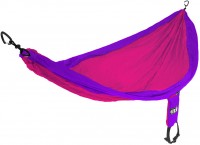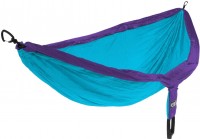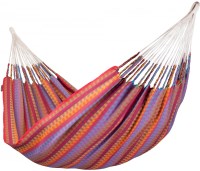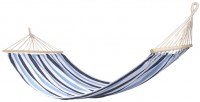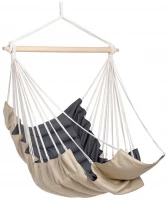Hammocks Amazonas
All Hammocks Advanced filters → |
You might be interested in
Hammocks: specifications, types
Type
The type is directly related to the design and application features of the product.
- Hammock. In this case, we mean classic hammocks - products in the form of a rectangular piece of fabric or mesh, suspended lengthwise at two opposite ends. Such products are intended mainly for sleeping or lying down; they require two hanging points, but there are also free-standing models equipped with their own frame (see below).
— Hammock chair. Such models can be described as a “sit-down” version of the hammocks described above. The key difference lies in the design, or more precisely, in the method of hanging a piece of fabric: it clings not to the “head” and “legs”, but to the sides - in a special way, so that the fabric takes the shape of the seat. In this case, one point is enough for hanging. In accordance with the name, such hammocks are intended to be used sitting or reclining.
— Hanging chair. The key feature of hanging chairs is the presence of a rigid base on which a soft “seat” and backrest are installed. Such furniture is usually equipped with its own frame (see below), which allows it to be placed on any relatively flat surface; this is especially convenient in open places where there are no branches, crossbars or other improvised support points. The chair is called “hanging” because the base with the seat is attached to the frame precisely with the help of a suspension; t...hanks to this you can rock in the chair.
Children's hanging chairs - models of hanging furniture designed for children's - fall into the same category. All such chairs differ from “adult” products in their reduced size and bright design, but there are no clear requirements for the design: some are a round seat suspended in a fabric “bag” with an opening for the rider, others use a suspension as a way to attach the base with the seat to the frame. The age category of children's's hanging chairs can also be different: usually such models are designed for older children's, but some can even be used as a cradle for newborns.
- Hammock. In this case, we mean classic hammocks - products in the form of a rectangular piece of fabric or mesh, suspended lengthwise at two opposite ends. Such products are intended mainly for sleeping or lying down; they require two hanging points, but there are also free-standing models equipped with their own frame (see below).
— Hammock chair. Such models can be described as a “sit-down” version of the hammocks described above. The key difference lies in the design, or more precisely, in the method of hanging a piece of fabric: it clings not to the “head” and “legs”, but to the sides - in a special way, so that the fabric takes the shape of the seat. In this case, one point is enough for hanging. In accordance with the name, such hammocks are intended to be used sitting or reclining.
— Hanging chair. The key feature of hanging chairs is the presence of a rigid base on which a soft “seat” and backrest are installed. Such furniture is usually equipped with its own frame (see below), which allows it to be placed on any relatively flat surface; this is especially convenient in open places where there are no branches, crossbars or other improvised support points. The chair is called “hanging” because the base with the seat is attached to the frame precisely with the help of a suspension; t...hanks to this you can rock in the chair.
Children's hanging chairs - models of hanging furniture designed for children's - fall into the same category. All such chairs differ from “adult” products in their reduced size and bright design, but there are no clear requirements for the design: some are a round seat suspended in a fabric “bag” with an opening for the rider, others use a suspension as a way to attach the base with the seat to the frame. The age category of children's's hanging chairs can also be different: usually such models are designed for older children's, but some can even be used as a cradle for newborns.
Number of seats
The number of people for which the hammock is designed.
Classic hammocks (see "Type") can be either single or double ; the latter implies not only the corresponding dimensions — not already 110 cm — but also an increased maximum load (see below) — not less than 140 kg. But hanging furniture of other types, almost all is made single.
Classic hammocks (see "Type") can be either single or double ; the latter implies not only the corresponding dimensions — not already 110 cm — but also an increased maximum load (see below) — not less than 140 kg. But hanging furniture of other types, almost all is made single.
Maximum load
The maximum load allowed for a hammock, in other words, the weight that the product is guaranteed to withstand. Although this limit is often given with a certain margin (assuming that a person can move, swing, etc.), it still cannot be exceeded: even if the hammock did not break right away, this can happen at any moment (even later, at an acceptable load).
Note that for double products (see "Number of seats") in this case, the total maximum load is given. At the same time, the weight in hammocks is distributed evenly, so pairs of people who differ markedly in physique can use them — the main thing is that the total weight does not exceed the permissible maximum.
Note that for double products (see "Number of seats") in this case, the total maximum load is given. At the same time, the weight in hammocks is distributed evenly, so pairs of people who differ markedly in physique can use them — the main thing is that the total weight does not exceed the permissible maximum.
Rail
The presence of a rail in the design of the hammock.
A rigid rail is used in the suspension system; its purpose depends on the type of product (see above). So, in some classic hammocks, two slats are used — in the head and in the legs. This design is actually a simplified version of the frame: it provides lateral tension to the fabric, due to which the hammock sags less under load than a frameless hammock, its edges do not “envelop” the lying person so much, and the bed retains a rectangular shape. But for hammock chairs, the rail is mandatory: in such products, both edges of the fabric cling to it and the rail is already hung on a tree, crossbar, etc.
A rigid rail is used in the suspension system; its purpose depends on the type of product (see above). So, in some classic hammocks, two slats are used — in the head and in the legs. This design is actually a simplified version of the frame: it provides lateral tension to the fabric, due to which the hammock sags less under load than a frameless hammock, its edges do not “envelop” the lying person so much, and the bed retains a rectangular shape. But for hammock chairs, the rail is mandatory: in such products, both edges of the fabric cling to it and the rail is already hung on a tree, crossbar, etc.
Frame
The presence of a rigid frame in the design of hanging furniture.
In this case, it does not mean a rigid “frame” around a bed or seat (although it is often provided), but a stand that allows you to use the product regardless of trees, walls and other external supports. It can also be used to secure a canopy (see below). Such a stand is an indispensable part of the design of hanging chairs (see "Type"), however, it is also found in classic hammocks; in the latter case, it may be possible to remove the canvas from the frame and hang it in the classical way, on external supports.
In this case, it does not mean a rigid “frame” around a bed or seat (although it is often provided), but a stand that allows you to use the product regardless of trees, walls and other external supports. It can also be used to secure a canopy (see below). Such a stand is an indispensable part of the design of hanging chairs (see "Type"), however, it is also found in classic hammocks; in the latter case, it may be possible to remove the canvas from the frame and hang it in the classical way, on external supports.
Canopy
The presence in the design of the product of a canopy — a fabric "roof" over a sleeping / sitting place.
The design and use of such a "roof" may be different. So, in some models it is intended mainly to create shade in sunny weather, in others it can also cover from rain, in others it is installed on a frame (see above) and can unfold, turning the structure into a full-fledged tent. However, anyway, the canopy provides a certain degree of additional protection against unpleasant factors.
The design and use of such a "roof" may be different. So, in some models it is intended mainly to create shade in sunny weather, in others it can also cover from rain, in others it is installed on a frame (see above) and can unfold, turning the structure into a full-fledged tent. However, anyway, the canopy provides a certain degree of additional protection against unpleasant factors.
Pillow
A pillow is included with the hammock. This feature not only relieves the user of the need to purchase a pillow separately — the complete product also optimally matches the hammock in appearance and design features. In some models, even a special attachment system may be provided to prevent the pillow from falling off the hammock.
Mosquito net
The presence of a mosquito net in the scope of delivery of the product. Such a mesh protects the person inside from mosquitoes and other annoying insects and at the same time does not interfere with air circulation. This option is found mainly in hammocks, while additional supports or the installation of a complete canopy (see above) may be required to place the net.
Carrying bag
A carrying bag is included with the hammock. The advantage of such a bag over "non-native" packages is that it is initially optimized specifically for this product — in size, layout, etc. In addition, the bag is usually designed to store complete accessories like a pillow (see above).
Fabric type
The type of fabric used in the construction of a hammock.
— Fabric. A traditional heavy fabric that gives the impression of a solid surface. The most convenient, versatile and, as a result, a popular type of fabric used in most models of modern hanging furniture.
— Grid. The surface is in the form of a grid — cells woven from individual threads. The main difference from the fabric lies precisely in the fact that the surface is not continuous. This design is well suited primarily for hot weather — it provides excellent skin ventilation. However a large mesh is not very convenient: the ropes can put a lot of pressure on the body, especially when sitting / lying in one position for a long time, and it’s more difficult to lean on such a surface (for example, with your hand, getting up from it) than on a fabric one. But there are also fine-mesh nets, which in fact are not too different from the fabric.
— Fabric. A traditional heavy fabric that gives the impression of a solid surface. The most convenient, versatile and, as a result, a popular type of fabric used in most models of modern hanging furniture.
— Grid. The surface is in the form of a grid — cells woven from individual threads. The main difference from the fabric lies precisely in the fact that the surface is not continuous. This design is well suited primarily for hot weather — it provides excellent skin ventilation. However a large mesh is not very convenient: the ropes can put a lot of pressure on the body, especially when sitting / lying in one position for a long time, and it’s more difficult to lean on such a surface (for example, with your hand, getting up from it) than on a fabric one. But there are also fine-mesh nets, which in fact are not too different from the fabric.
Material
The main material used in the construction of the product.
— Artificial rattan. Material imitating rattan is a kind of wicker, popular in furniture production. Such a substitute (based on plastic fibre) has a number of advantages over natural rattan — in particular, it is not so sensitive to moisture and ultraviolet radiation, unpretentious in care and storage, can have any texture and colour, and is much cheaper. This material is used exclusively in hanging chairs (see "Type") — it is used to make rigid bases for seats and backs. Thus, inexpensive and practical furniture is obtained, very similar to natural wicker.
— Cotton. A classic material that does not lose popularity today. Cotton fabric can be either pure or with various additives. Its strength may be somewhat lower than that of other materials, but such products are still strong enough, reliable and durable for use in the main application. And from the point of view of the user, cotton is also pleasant to the touch, it is considered the most “natural” and “environmentally friendly”, and the skin “breathes” through it. Due to this, this material is the most popular, and both fabric and mesh can be made from it (see "Web type").
— Nylon. Quite a popular "tourist" material of synthetic origin. By itself, nylon is quite durable and at the same time inexpensive, but not very resistant to moisture (it tends to stretch when wet) and ultraviolet radiation....At the same time, various varieties of this material can be used in the design — from the simplest large-mesh mesh made of nylon threads to dense cordura-type fabric, which, due to special processing, is able to endure even quite extreme conditions. Usually the quality of a nylon product directly depends on its price category.
— Polyester. Another popular "tourist" material that is noticeably superior to nylon in terms of strength, moisture resistance and durability. However, polyester products are noticeably more expensive, despite the fact that the mentioned advantages in most cases do not play a decisive role. As a result, this material is quite rare, mainly in high-quality products.
— Polypropylene. According to the main characteristics, this material is similar to the polyester described above. At the same time, polypropylene is more elastic (because it stretches better), less dense (with the same weight, the fabric turns out to be more voluminous or even “fluffy”) and not so sensitive to greasy stains (they are difficult to remove from polyester). The disadvantages of this material are somewhat lower strength and resistance to heat.
— Artificial rattan. Material imitating rattan is a kind of wicker, popular in furniture production. Such a substitute (based on plastic fibre) has a number of advantages over natural rattan — in particular, it is not so sensitive to moisture and ultraviolet radiation, unpretentious in care and storage, can have any texture and colour, and is much cheaper. This material is used exclusively in hanging chairs (see "Type") — it is used to make rigid bases for seats and backs. Thus, inexpensive and practical furniture is obtained, very similar to natural wicker.
— Cotton. A classic material that does not lose popularity today. Cotton fabric can be either pure or with various additives. Its strength may be somewhat lower than that of other materials, but such products are still strong enough, reliable and durable for use in the main application. And from the point of view of the user, cotton is also pleasant to the touch, it is considered the most “natural” and “environmentally friendly”, and the skin “breathes” through it. Due to this, this material is the most popular, and both fabric and mesh can be made from it (see "Web type").
— Nylon. Quite a popular "tourist" material of synthetic origin. By itself, nylon is quite durable and at the same time inexpensive, but not very resistant to moisture (it tends to stretch when wet) and ultraviolet radiation....At the same time, various varieties of this material can be used in the design — from the simplest large-mesh mesh made of nylon threads to dense cordura-type fabric, which, due to special processing, is able to endure even quite extreme conditions. Usually the quality of a nylon product directly depends on its price category.
— Polyester. Another popular "tourist" material that is noticeably superior to nylon in terms of strength, moisture resistance and durability. However, polyester products are noticeably more expensive, despite the fact that the mentioned advantages in most cases do not play a decisive role. As a result, this material is quite rare, mainly in high-quality products.
— Polypropylene. According to the main characteristics, this material is similar to the polyester described above. At the same time, polypropylene is more elastic (because it stretches better), less dense (with the same weight, the fabric turns out to be more voluminous or even “fluffy”) and not so sensitive to greasy stains (they are difficult to remove from polyester). The disadvantages of this material are somewhat lower strength and resistance to heat.
Weaving density
The weave density of the fabric used in the hammock. For mesh (see "Web type"), this indicator is usually not indicated.
The greater the weight of one square metre of fabric, the denser it is, which, on the one hand, increases strength and water resistance, on the other hand, affects the weight of the entire product and reduces air permeability (which can create discomfort in hot weather).
The smallest density value found in modern hammocks is about 180 g/m², the largest is about 390 g/m².
The greater the weight of one square metre of fabric, the denser it is, which, on the one hand, increases strength and water resistance, on the other hand, affects the weight of the entire product and reduces air permeability (which can create discomfort in hot weather).
The smallest density value found in modern hammocks is about 180 g/m², the largest is about 390 g/m².
Size
General dimensions of the product in length and width.
The width of a bed in a hammock usually corresponds to the total width (second number). But the length of the canvas (see below) is, by definition, less than the total length. However, sometimes manufacturers indicate the dimensions without specifying what exactly they are talking about — about the general dimensions or only about the canvas. In such cases, the same length value is indicated in both clauses; if it is not possible to clarify what exactly we are talking about, the product should be chosen with a certain margin (the canvas is usually 10 — 15% shorter than the entire hammock).
The width of a bed in a hammock usually corresponds to the total width (second number). But the length of the canvas (see below) is, by definition, less than the total length. However, sometimes manufacturers indicate the dimensions without specifying what exactly they are talking about — about the general dimensions or only about the canvas. In such cases, the same length value is indicated in both clauses; if it is not possible to clarify what exactly we are talking about, the product should be chosen with a certain margin (the canvas is usually 10 — 15% shorter than the entire hammock).
Fabric length
The length of the canvas in hammocks and hammock chairs (see "Type"), in other words — the dimensions of the sleeping / sitting place in length. In the first case, the length of the canvas, usually, is less than the total length of the structure, because fasteners are not taken into account in this case. But hammock chairs are usually folded into a "shell", and here it is the other way around — the overall dimensions are less than the length of the canvas.

